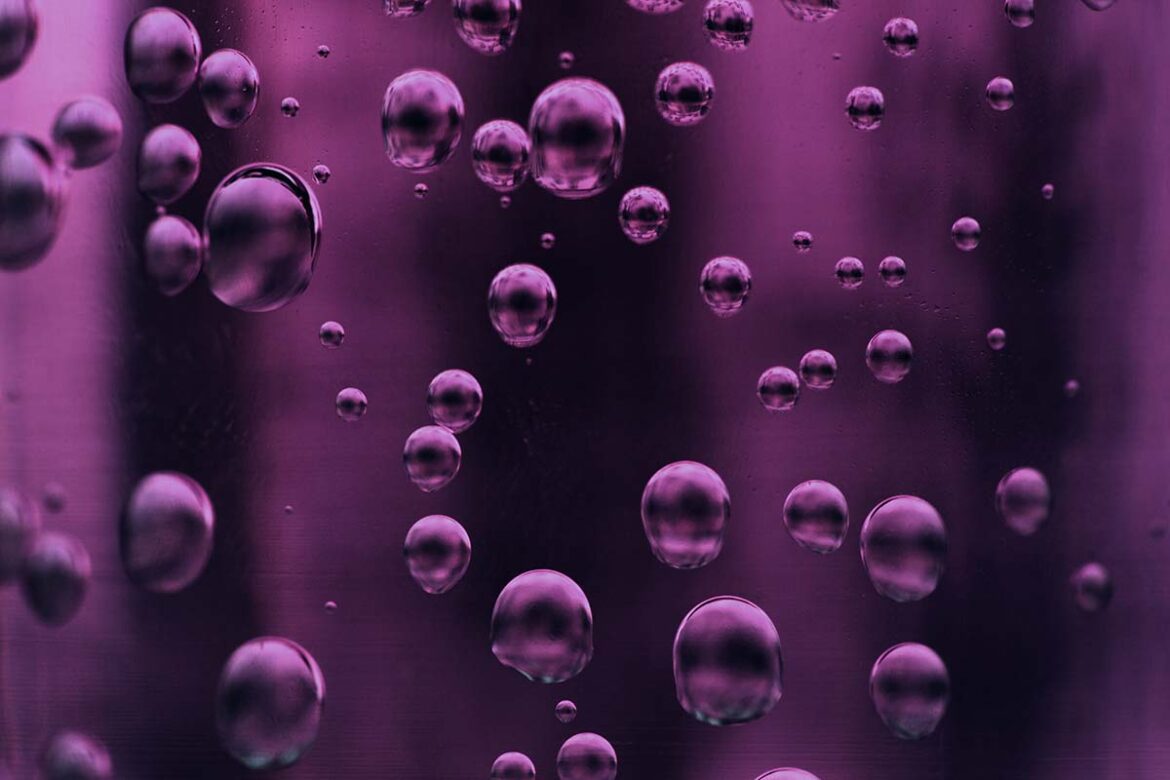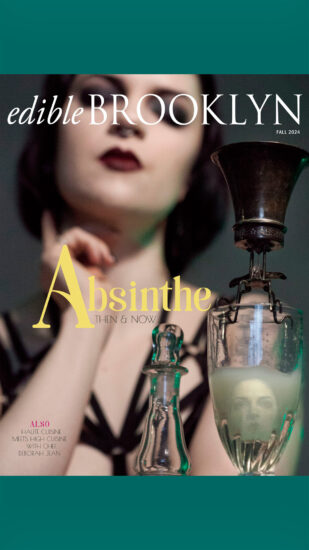If you’re a Brooklynite of a certain era, you don’t need me to sell you on seltzer.
We’re talking about the real deal, of course: the refillable blue glass bottle brought to your stoop, or the candy store squirt into a cherry lime rickey.
For younger readers—or recent arrivals to the borough—seltzer is carbonated water, once available largely by delivery in siphon-topped bottles. Today, seltzer is commonly found in grocery stores, but it goes flatter far faster. Tucked in between the club soda (which has added salts) and tonic water (which has quinine), you might find it filed under “sparkling water,” its name outside the Northeast.
The first seltzer came from Germany, says The Oxford Encyclopedia of Food and Drink in America. There, naturally bubbly water with a high mineral content was found in the town of Niederselters, which began exporting it to the Colonies by the 1700s. Tinkerers in both continents figured out how to make it themselves, eventually leaving out the added minerals. Meanwhile, many Eastern Europeans (mainly Jews) came to Brooklyn, bringing their love of seltzer with them.They became seltzer buyers, bottlers and doorstep deliverymen, their glory days lasting the 50 years between the 1920s and the 1960s.
Back then, says Kenny Gomberg, who runs Gomberg Seltzer Works in Canarsie with his brother-in-law Irv Resnick, “there were many seltzer shops, and there were hundreds, hundreds of seltzer men.”
Because each seltzer man had his own route of loyal customers, says Gomberg, seltzer makers “really had to take care of them.” His grandfather paid one seltzer man $500 just to deliver his seltzer, he says, while Brooklyn soda syrup companies like Fox’s U-Bet covered the costs of painting their trucks.
THE NEW MONITOR ON AVENUE D
Payoffs are no longer a problem for the 48-year-old Gomberg, whose Russian grandfather started the Brooklyn works in 1953. As the only seltzer maker in town (and one of just a handful in the country, due to an elderly customer base, supermarket sodas and nobody home to catch deliveries), he’s the one keeping the city’s eight seltzer men in business.
Gomberg and Resnick now make seltzer just three days a week on Avenue D and East 92nd Street, hidden in a concrete building at the back of their beer, snack and cigarette distribution company. Not surprisingly, it’s an old fashioned business: Gomberg keeps the names of his seltzer men and their weekly fill-ups—about 3,000 bottles total—on an index card. The equipment itself, well, “it looks like a still,” says Gomberg, and he’s right.
There are no conveyor belts or white lab coats here, just slender copper tubing, a bit of ancient metal machinery and hundreds of beautiful seltzer bottles, some nearly 150 years old. In scratch-marred shades of blue, green and what was once clear glass, many are etched with names of long-gone Brooklyn seltzer works: Manhattan Sparkling Beverages, Nathan Wanshel or Carl N. Schultz.
They’re stacked all over the room by the seltzer men, who pop in and out all week to pick up fresh bottles and drop off the empties, most in rickety wooden crates designed to hold 10 26- ounce bottles at once. (Seltzer men supply their own bottles, says Gomberg, so they buy them up whenever they can. Most were manufactured in Czechoslovakia in the 1800s, but you can spot mid-20th century bottles by their seams, he says, as well as a few plastic siphon tops made in Argentina.)
In the middle of all this antique glass is Luis Machica, Gomberg’s official seltzer filler for the past decade. Machica mans the 100-year-old, London-made Barnett & Foster six-bottle filler, proudly labeled “The New Monitor.” (Gomberg actually has four: One is ready to go if the other breaks down; he scavenges others for parts.)
But before Machica can fill the bottles, he has to have seltzer. At Gomberg, New York City tap water is triple-filtered through layers of sand, charcoal and paper, chilled—since cold water absorbs more carbon dioxide—then pumped into a carbonator, where two paddles beat the water together with carbon dioxide gas.
Machica then takes over, loading empty bottles upside down into the cast iron bottler, where the water is forced down through the spout.
The result, still cool to the touch, is one bottle of pure Gomberg seltzer. “This is the best seltzer you will ever taste,” says Machica, offering a freshly made sample in a Styrofoam cup.Tickling the nose, sparked with flavors you’d swear were lemons, limes and rejuvenating minerals, it’s wickedly bubbly, rocking in the cup like a mini-earthquake.
RONNY THE SELTZER MAN
For most Gomberg seltzer aficionados, however, seltzer’s appeal is more than just those powerful bubbles—it’s also their seltzer man. Notoriously social, “they spend so much time with their customers,” says Gomberg, “I don’t know how they get their work done.”
Gomberg’s eight seltzer men—who deliver to Brooklyn, Manhattan, Queens, the Bronx, Connecticut and Westchester—include Walter Backerman, a third-generation seltzer man, and Steve Levine, a veteran seltzer man whose labels read “Cowboy Deliveries: Life’s Perfect Drink.”
For most Brooklynites, Ronny Beberman—or “Ronny the seltzer man”—is by far the most famous. While other seltzer men have vans, Beberman drives the very last of Brooklyn’s real seltzer trucks—an old-fashioned, rattling contraption, loaded with bottles perilously perched on either side.
It’s the third seltzer truck Beberman has owned since he started in 1970, and you might have seen it flying around town. (It says “Marty Shindelman,” the seltzer man Beberman bought it from a decade ago.)
Six days a week, starting at 5 a.m., Beberman rumbles from Canarsie to Prospect Heights, Borough Park, Midwood, Bedford Stuyvesant, Park Slope, Clinton Hill or Carroll Gardens. Still strapping at 58, he makes deliveries to more than 100 customers—some old, some young, some new to Brooklyn, each paying $20 for a wooden crate of 10 bottles delivered every other week. (For seltzer, specialty sodas and syrup deliveries, contact the Gomberg Seltzer Works, 718-257-9369, weekdays, 8 a.m.-4 p.m.) In his 36th year as a Brooklyn seltzer man, Beberman admits the work is hard: There’s winter’s cold and summer’s heat, plus lifting many 70-pound cases of seltzer a day. Even so, he can’t imagine another job: “If I left this,” he says, easily hoisting a case of bottles into his truck, “I don’t know what I’d do.” Luckily for seltzer fans, however, Beberman is still young for this business. “When I was a little boy,” says Gomberg, “there were guys in their seventies shlepping seltzer.”
Plus, Gomberg has no plans to shutter the seltzer side of his business—as long as there are enough paying customers to keep it afloat.
“It’s in my heart,” he says, touching his chest with his hand, motioning at all the blue and green glass he keeps in circulation.”It’s part of who I am.”
Luckily for us, that means it’s part of Brooklyn, too.
EGG CREAM
From Lou Reed’s “Egg Cream”
Seltzer
Whole Milk
U-Bet Chocolate Syrup (All ingredients to taste.)
“When I was a young man—no bigger than this,
A chocolate egg cream was not to be missed.
Some U-Bet’s Chocolate Syrup, seltzer water mixed with milk.
Stir it up into a heady fro—tasted just like silk.
You scream, I steam,
We all want Egg Cream.”
Bottles waiting to be filled and delivered.



